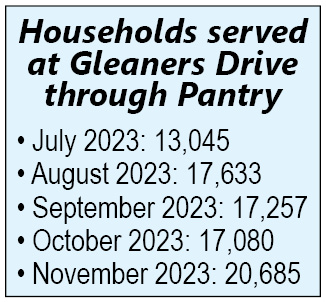Gleaners Food Bank of Indiana President and CEO Fred Glass reports that Gleaners is seeing a significant spike in the number of households seeking food assistance which began last summer and is continuing through the holidays.

Glass
“In our fiscal year 2023, ending in September, Gleaners distributed an all-time record 48 million meals throughout our 21-county service area, 17 percent higher than the last year and 88 percent higher than the year before the pandemic,” Glass said. “Since June, the number of households we’re serving just at our own on-site pantry has increased by nearly 28 percent.”
Many people don’t realize that Gleaners must buy nearly half of the food that it in turn provides to people facing hunger. Glass noted that Gleaners’ food purchase budget of $7.7 million, the highest in the organization’s 43-year history, is already being stretched.
“Despite having conservatively planned this year for a significant increase in our food budget, our recent distributions are running well over that increased budget,” Glass said. “My big concern is that even this record budget may not be enough.”
The increase in need is not just being seen at Gleaners’ on-site pantry or just in Marion County pantries, but throughout the food bank’s 21-county service area.
 “Marion County, our most populous, is up 11 percent, but so is Hamilton County. Wayne County is up 16 percent, Bartholomew County is up 13 percent. It’s across the board,” Glass said. “The trend is national. The October 2023 USDA report on household food insecurity in the U.S. in 2022 revealed that one in seven Americans (44 million) live in food insecure households including one in five children (15 million). This is a 30 percent and 40 percent increase, respectively, from the previous year and the highest percentages since 2014.”
“Marion County, our most populous, is up 11 percent, but so is Hamilton County. Wayne County is up 16 percent, Bartholomew County is up 13 percent. It’s across the board,” Glass said. “The trend is national. The October 2023 USDA report on household food insecurity in the U.S. in 2022 revealed that one in seven Americans (44 million) live in food insecure households including one in five children (15 million). This is a 30 percent and 40 percent increase, respectively, from the previous year and the highest percentages since 2014.”
Despite indicators showing a strong economy, hundreds of thousands of Hoosiers are struggling. Rent increases place Indianapolis as high as third nationally. While food inflation has slowed, it is still outpacing wage gains for low-income workers.
“We hear from our neighbors that while the vast majority are working, sometimes more than one job, their wages simply aren’t sufficient to meet the family’s basic needs,” Glass said. “Of those needs – such as housing, utilities, childcare, and health care – food is the most accessible and flexible to successfully address. If a neighbor goes to one of our pantries, they will receive food. This not only helps them meet their immediate need to eat but can free up time and resources to help them pay their rent, keep on their lights, and buy medicine.”
To learn more about hunger in your community and how you can get involved, visit gleaners.org.

